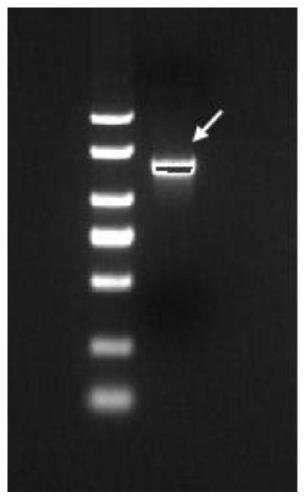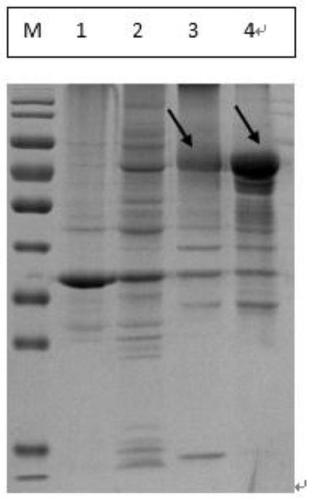A kind of duck Tembusu virus e protein truncated protein and application
A technology of duck Tembusu virus and protein, which is applied in the direction of antiviral immunoglobulin, virus, viral peptide, etc., can solve the problem of unstable expression, and achieve the effect of high sensitivity, large sample size and good stability
- Summary
- Abstract
- Description
- Claims
- Application Information
AI Technical Summary
Problems solved by technology
Method used
Image
Examples
Embodiment 1
[0049] Obtaining of E truncated protein of DTMUV DF2 strain:
[0050] (1) DTMUVDF2 chicken embryo virus, take 200 μL, add 800 μL of Trizol reagent, mix well, let stand at room temperature for 5 minutes, add 200 μL of chloroform, shake vigorously for 15 seconds, ice bath for 10 minutes, 4 ° C, 12000 rpm, centrifuge for 15 minutes, take 600 μL Put the supernatant into a clean EP tube, add an equal volume of isopropanol solution, mix gently, let stand at room temperature for 10min, 4°C, 12000rpm, centrifuge for 10min, discard the supernatant, add 1mL absolute ethanol to the EP tube, mix gently , 4°C, 7500rpm, centrifuge for 5min, discard the supernatant, dry at room temperature, add 13μL DEPC water to dissolve, and store at -20°C.
[0051] (1) reverse transcription:
[0052] Add components according to the following system: AMV reverse transcriptase 0.5 μL, 5 times AMV reverse transcription buffer 4 μL, RRI 1 μL, random primer 1 μL, dNTPS 2 μL, RNA template 11.5 μL, a total of 2...
Embodiment 2
[0070] Obtaining of hybridoma cell line 4A10:
[0071] (1) Three healthy ducks were taken, blood was collected from the carotid artery, placed at 37°C for 30 minutes, and then separated at 4°C overnight, and the serum was collected. Extract duck serum IgG with caprylic acid-ammonium sulfate method, the specific operation is as follows: centrifuge the collected duck serum at 4°C and 4000rpm for 3 minutes, take the supernatant, add 4 times the volume of 60mM / L sodium acetate solution of pH 4.5, add as you go Stir, add 25 μL of n-octanoic acid per 1 mL of the above serum, let stand at room temperature for 30 min, centrifuge at 12,000 rpm for 10 min at 4°C, take the supernatant, filter with filter paper, and adjust the pH to 7.4 after filtration. Add a final volume of less than or equal to 45% saturated ammonium sulfate solution while stirring, stir at room temperature for 30 minutes, centrifuge at 4000rpm at 4°C for 10 minutes, remove the supernatant, resuspend the precipitate wi...
Embodiment 3
[0081] Obtaining enzyme-labeled secondary antibodies
[0082] (1) Preparation and purification of mouse anti-duck IgG mouse ascites:
[0083] The hybridoma cell line 4A10 was taken out from the liquid nitrogen tank, revived, and expanded for culture. Three days to one week in advance, BALB / C female mice aged 8-10 weeks were injected intraperitoneally with 0.5 mL of Freund's incomplete adjuvant per mouse. The expanded hybridoma cells were counted with a cell counting plate, according to 5*10 5 Each mouse was injected intraperitoneally, and after 7-10 days, the ascites of the mice was collected every day until the mice died. The collected ascites was centrifuged at 12000 rpm for 5 mins, the precipitate was discarded, thimerosal was added to the supernatant with a final concentration of 0.01%, and stored at -80°C after aliquoting. Purify according to caprylic acid-ammonium sulfate method to obtain 4A10 monoclonal antibody, ie mouse anti-duck IgG.
[0084] (2) HRP-labeled mous...
PUM
 Login to View More
Login to View More Abstract
Description
Claims
Application Information
 Login to View More
Login to View More - R&D
- Intellectual Property
- Life Sciences
- Materials
- Tech Scout
- Unparalleled Data Quality
- Higher Quality Content
- 60% Fewer Hallucinations
Browse by: Latest US Patents, China's latest patents, Technical Efficacy Thesaurus, Application Domain, Technology Topic, Popular Technical Reports.
© 2025 PatSnap. All rights reserved.Legal|Privacy policy|Modern Slavery Act Transparency Statement|Sitemap|About US| Contact US: help@patsnap.com



